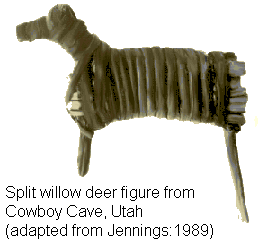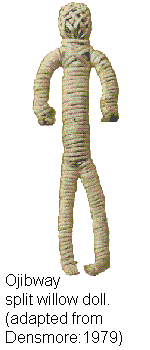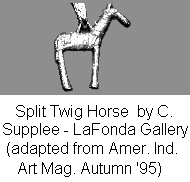
Native Americans, thousands of years ago to the present,
have made animal figures and representations of peoples out of
split willow sticks. In the Great Basin and Grand Canyon areas
of southwestern North America, willow figures of deer have been
found that are thousands of years old. In more recent times, willow
dolls have been made by Native Americans of the Great Lakes area.
To the present day, Native Americans have continued to use the
willow figures in creating contemporary art.

On the Colorado Plateau of Utah, in Cowboy Cave,
archaeologists have found many split willow figures representing
deer, some that were made by Native Americans 3,500 years ago.
Often these ancient split willow deer are found in ceremonial
contexts, but in this cave they were found battered and broken
among ordinary refuse in layers of fill, suggesting that the deer
had a more secular use, perhaps as children's toys. Some of these
deer more aptly resemble a llama, having a tall body and short
legs. In making the willow deer, only a single unbroken split
willow is needed. A long branch is split down its length, leaving
the last few inches of the wide end unsplit. The unsplit end of
the branch forms the rear leg, and the two halves of the split
branch are used to wrap the body and form the head.
Basket-like figures made of willow branches have
also been found in Arizona, Coconio County, in Stanton's Cave.
 The figures of deer here were made by Native Americans more than
3,000 years ago. The willow deer from Stanton's Cave indicate
the unsplit end was used to make the head, and bending of one
of the split halves through the split end formed the deer's nose.
Additional folds of the split branches helped create the body
and legs. The Stanton Cave willow deer are finished by using the
end of the willow lashing to penetrate the wrappings of the deer's
body, so that the end sticks out like a spear. Perhaps indicating
the deer representation had been ritually 'killed'?
The figures of deer here were made by Native Americans more than
3,000 years ago. The willow deer from Stanton's Cave indicate
the unsplit end was used to make the head, and bending of one
of the split halves through the split end formed the deer's nose.
Additional folds of the split branches helped create the body
and legs. The Stanton Cave willow deer are finished by using the
end of the willow lashing to penetrate the wrappings of the deer's
body, so that the end sticks out like a spear. Perhaps indicating
the deer representation had been ritually 'killed'?
In her early 1900's work with the Ojibway (Chippewa)
people living on reservations in Minnesota, Densmore photographed
and described a child's doll made from split willow. This elongated
doll was made by a woman living at Grand Marais, on Lake Superior's
north shore. The doll's head is made of checker-woven willow withes,
that are bent around to form the doll's head. The core of doll's
body, arms and legs consists of bundled grass or cornhusk that
 is simply wrapped with split willow branches. Densmore noticed,
and the same is true for many other traditionally made dolls,
that the features or details of the doll's face are not outlined.
In contrast to the one-piece split willow deer, a dozen or more
shorter pieces of split willow are used to make this Ojibway doll.
is simply wrapped with split willow branches. Densmore noticed,
and the same is true for many other traditionally made dolls,
that the features or details of the doll's face are not outlined.
In contrast to the one-piece split willow deer, a dozen or more
shorter pieces of split willow are used to make this Ojibway doll.
Present day Native American artists have perpetuated
images of the split willow figures in modern jewelry making. Many
contemporary southwestern Native American magazines and galleries
depict necklaces with cast or wire-wrapped 'split twig' animal
charms and pendants.
Branches, Twigs & Roots Bibliography and Books to Buy On-Line

© 1994-1999 Tara Prindle.